• What should we make of AD Mitchell's production profile? Mitchell and Brian Thomas Jr. would be the two lowest-graded receivers to be drafted in the first round since 2017, but he has clear talent.
• Laiatu Latu is poised for a fruitful NFL career: While production alone isn’t a guarantee for NFL success, elite production plus a baseline level of size and athleticism plus quality level of competition is generally a winning formula. Latu checks those boxes.
• Draft and trade for yourself: Try PFF's Mock Draft Simulator — trade picks and players and mock for your favorite NFL team.
Estimated Reading Time: 11 minutes
Click here for more draft tools:
2024 Mock Draft Simulator | 2024 Big Board | 2024 Draft Guide
2024 Player Profiles | 2024 Mock Drafts | NCAA Premium Stats
A lot of numbers get thrown around during draft season, and it’s sometimes difficult to place them in a proper context. PFF’s college data (stretching back to 2014) and NFL data (2006) can help fill in some of the blanks when looking at questions surrounding some of the top prospects at each position in the 2024 NFL Draft.
PFF's Maurice Smith, Jason DeLoach, Andrew Shaver and Mike Manning contributed to this piece, pulling together noteworthy data points for top prospects at each position. And that starts with the projected first-overall pick, Caleb Williams.
In which areas is Caleb Williams’ ability to create obvious?
Williams has drawn comparisons to the likes of Aaron Rodgers and Patrick Mahomes. Regardless of the validity of those comparisons, the fact they exist at all speaks to his arm talent and ability to create outside of structure. That shows up when looking at some of Williams’ big-time throw numbers situationally.
Big-Time Throw Leader by Situation | Among QBs Drafted Since 2017, During NCAA Careers
| Situation | Most | 2nd Most | 3rd Most |
| Throws over four seconds | C. Williams: 23 | P. Mahomes: 20 | B. Mayfield: 14 |
| Moved off spot without reset | C. Williams: 22 | P. Mahomes: 21 | J. Allen: 15 |
| Throws to scramble-adjusted routes | C. Williams: 17 | M. Willis: 9 | 4 QB tied: 7 |
It’s also encouraging to see some of the other names toward the top of these lists. Mahomes slots in behind Williams in second place on throws coming over four seconds after the snap and “off-platform” throws where the quarterback is moved off their spot without resetting to throw. Josh Allen also shows up in the top five of each of the first two categories.
How does J.J. McCarthy’s usage (dropback rate in neutral game situations) compare to previous draft prospects?

A lot has been made about Michigan’s run-heavy approach and how much the team “trusted” McCarthy to drop back to pass. When isolating to more neutral game situations — early downs in the first three quarters of one-score games — the data only accentuates those concerns.
McCarthy will be one of three quarterbacks drafted since 2017 to have a dropback rate below 40% in those situations, and the only quarterback on that list who is currently projected as a starter is Joshua Dobbs. The flip side of this argument is that when McCarthy had to pass, in third-and-long situations, he was among the best quarterbacks in college football.
Trey Benson averaged 0.39 missed tackles forced per attempt over his college career. How does that compare to recent top RB prospects?
Benson is one of the more elusive running backs that PFF has recorded at the college level since charting began in 2014. Looking solely at running backs drafted in the top 100 since 2017, Benson’s 0.39 missed tackles forced per carry are tied for the most in that group with Bijan Robinson and Javonte Williams.
That elusiveness is something we’ve seen translate well to the NFL among running backs. Among the four others in the top five in missed tackles forced per carry — Robinson, Williams, Kenneth Walker and David Montgomery — all four rank among the top 30% at the position in missed tackles forced per carry since getting drafted.
How much of Marvin Harrison Jr.’s production was affected by QB play last season?
It’s hardly as if Harrison’s production was disappointing last season; his 0.42 PFF Wins Above Average was a top-10 mark among qualifying FBS wide receivers. But that number becomes even more impressive when viewed through the lens of how often he was given an opportunity to make a play, particularly on downfield targets.
Catchable Target Rate on Passes 10+ Yards Downfield in 2023 | Among Top-Five WRs on Consensus Big Board
| Receiver | Catchable Target % |
| Brian Thomas Jr. | 78% |
| Malik Nabers | 70% |
| Rome Odunze | 61% |
| Adonai Mitchell | 58% |
| Marvin Harrison Jr. | 57% |
Despite getting fewer quality downfield targets, Harrison still averaged 3.44 yards per route run this past season — second to Nabers among all Power Five wide receivers. Regardless of his landing spot, it’s difficult to see Harrison not making an immediate impact on his new offense.
Should Adonai Mitchell‘s production profile be concerning to teams in the first round?
Mitchell’s evaluation will vary significantly from team to team. He joins a select group of wide receivers who ran a 4.35-second 40-yard dash at above 6-foot-2 and 200 pounds. That list includes names like Julio Jones, Calvin Johnson and Randy Moss, but also names like Breshad Perriman, Kevin White and Devin Aromashodu.
Mitchell is clearly talented, and his highlight-reel plays can go toe-to-toe with any wide receiver in the class. The reason Mitchell is firmly outside of the expected top three prospects at the position is that those plays don’t come with enough regularity.
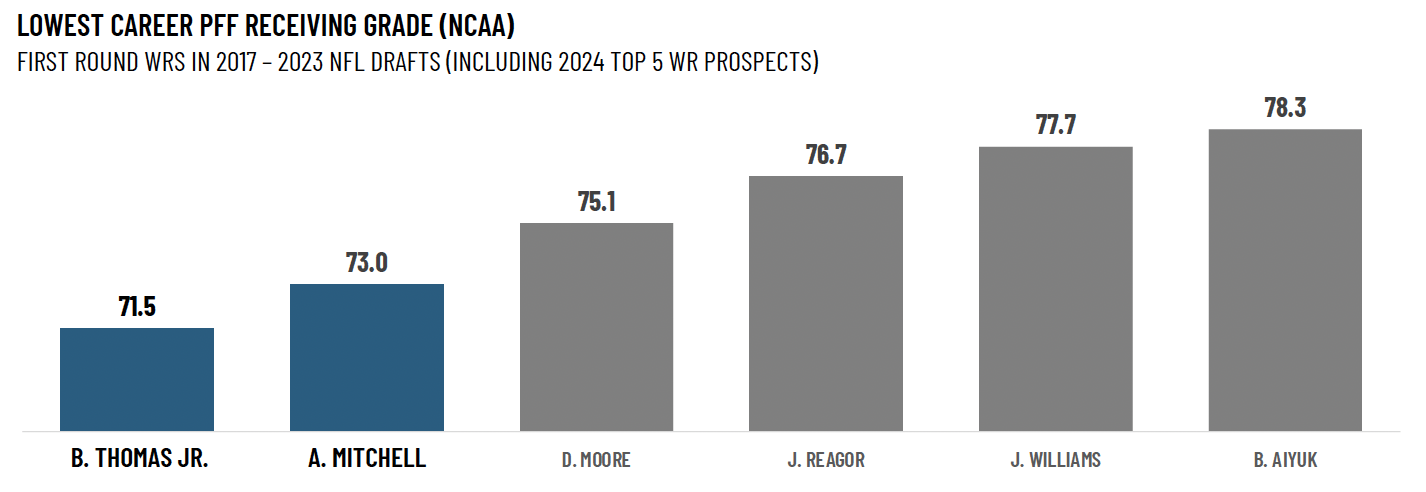
Mitchell and Brian Thomas Jr. would be the two lowest-graded receivers to be drafted in the first round since 2017. There are players here, like D.J. Moore and Brandon Aiyuk, who were able to turn underwhelming college production into strong starts to their NFL careers. Teams will have to weigh whether they are convinced Mitchell can join that group.
How does Brock Bowers’ ability after the catch set him apart?
Bowers is the most productive tight end after the catch since PFF began charting college football in 2014.
Brock Bowers‘s Career Numbers After the Catch | Ranks Among FBS TEs since 2014
| Statistic | Bowers’ Production and Rank |
| Yards after the catch | 1,487 (2nd behind Jaylen Samuels) |
| Yards after contact | 689 (1st) |
| Missed tackles forced | 44 (2nd behind Gerald Everett) |
After-the-catch ability has shown to translate fairly well from college to the NFL at tight end — seen most recently in Sam LaPorta, who was excellent after the catch at Iowa and parlayed that into immediate NFL success.
Joe Alt may be asked to transition to RT in the NFL despite playing 100% of OL snaps at LT in college. Which recent NFL RT predominantly played LT in college?
Depending on his landing spot, Alt might be asked to flip sides early in his NFL career. Teams with early selections, such as the Los Angeles Chargers (Rashawn Slater) and New York Giants (Andrew Thomas), already have established starters on the left side. Below is a list of players drafted since 2017 with at least 75% of their snaps at left tackle in college and at least 75% of their NFL snaps at right tackle (minimum of 500 total snaps).
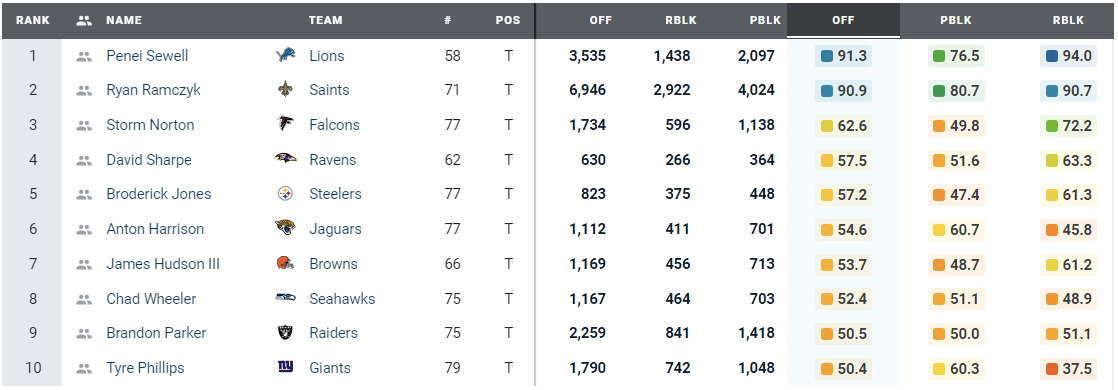
Sewell is likely the closest comparison as a player who came off the board early, and he’s been dominant on the right side early in his career. Ramczyk has also had plenty of NFL success, with several names further down the list (Broderick Jones and Anton Harrison) standing out as first-round picks who are still unknowns after just one season.
Amarius Mims played only 870 snaps over three seasons at Georgia. Are there recent first-round OT picks who played so few snaps in college?
Mims has one of the more interesting profiles in a sizeable tackle group that is expected to come off the board in the first round. He has some of the most impressive measurables you’ll see from a tackle prospect, performed well when on the field (75.0-plus PFF grades in the SEC in each of the past two seasons) but accumulated just eight starts and fewer than 1,000 offensive snaps before entering the draft.

Going back to 2017, Mims would be just the fifth first-round tackle with less than 1,500 Division I snaps, joining former teammate Broderick Jones, Penei Sewell, Garett Bolles and Ryan Ramczyk. Bolles and Ramczyk are the only two under 1,000 snaps, and they both played just one Division I season after transferring in from lower levels.
What run scheme does Zach Frazier fit best in at the NFL level?
The leaguewide average percentage of runs that PFF charts as “man” concepts — primarily consisting of duo runs — has crept up in recent seasons. The average sat at 16.9% in 2023, the highest it has been since PFF began charting run concepts in 2014. Frazier ties for the highest PFF run-blocking grade in college football on those runs since the 2020 season.
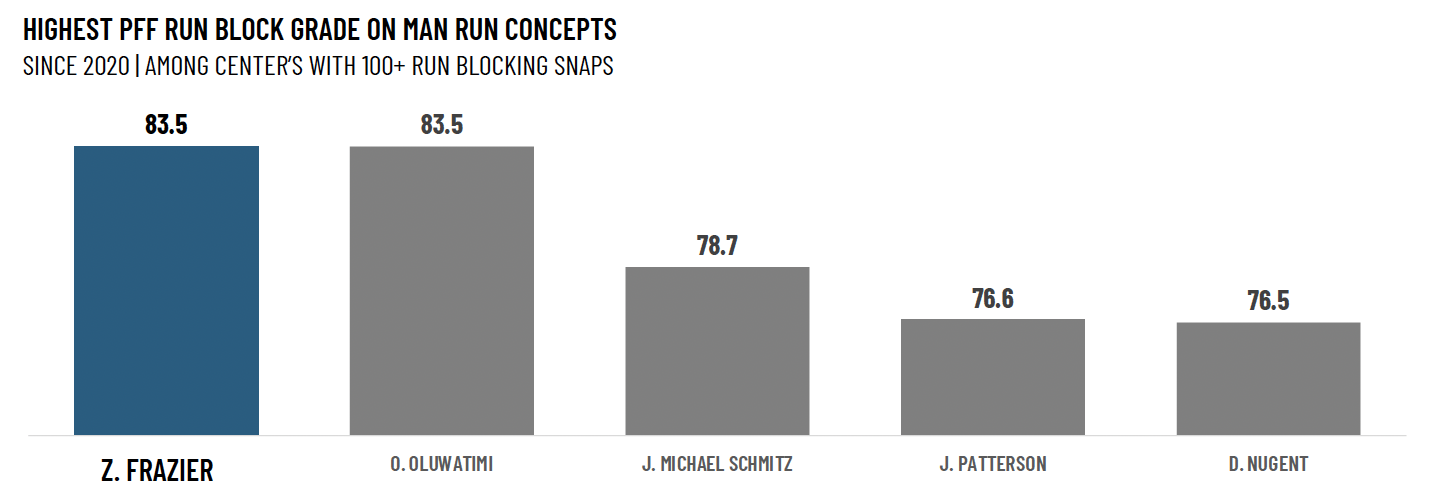
Over the course of his college career, Frazier graded out in at least the 50th percentile at the position on both zone and gap-scheme runs but would likely be best suited in a gap-heavy scheme that utilizes his power and flexibility.
Johnny Newton played 84% of defensive snaps for Illinois last season. How does that stack up with other top projected iDL prospects?
One of the differentiators for Newton and the other top interior defensive linemen in this class is the volume of snaps he played. Newton played at least 600 defensive snaps in each of the past three seasons, and he’s the only interior defensive lineman in the Power Five with at least 2,000 defensive snaps since 2021.
Percentage of Defensive Snaps Played in 2023 | Top-Five Projected IDL in the 2024 NFL Draft
| Player | % of Defensive Snaps Played |
| Jer’Zhan Newton | 84% |
| T’Vondre Sweat | 54% |
| Kris Jenkins | 47% |
| Byron Murphy | 47% |
| Braden Fiske | 46% |
Only 16% of Byron Murphy II’s career pressures were charted as “clean-up” or “unblocked.” How does that stack up against recent IDL prospects?
Murphy was one of the most efficient pass-rushing interior defensive linemen in college football during his time at Texas. Since 2021, his 12.5% pressure rate ranks third among defensive tackles with at least 500 pass-rush snaps, trailing only 2023 first-round selections Jalen Carter and Calijah Kancey. And those pressures didn’t come cheaply.
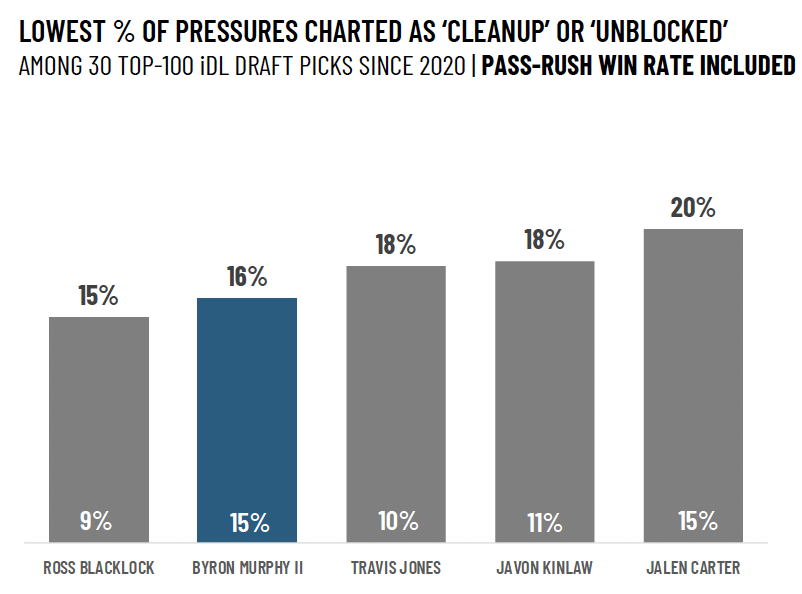
Murphy’s pressures largely came on the back of pass-rush wins rather than clean-up opportunities created by his teammates. Just 16% of his career pressures were charted as clean-up or unblocked pressures, which would rank second lowest among interior defensive linemen drafted in the top 100 since 2020.
How have recent edge defender prospects with a career pass-rush win rate of at least 20% in college fared in the NFL?
Nine edge rushers drafted since 2019 finished their college careers with pass-rush win rates of at least 20% on 250 or more pass-rushing snaps. Below are their NCAA and NFL pass-rush win rates.
Edge Rushers Drafted Since 2019 with 20%-Plus Pass-Rush Win Rates in College
| Player | NCAA Pass-Rush Win Rate | NFL Pass-Rush Win Rate |
| Nick Bosa | 24.5% | 18.2% |
| Josh Uche | 23.0% | 15.4% |
| Arnold Ebiketie | 21.7% | 9.7% |
| Curtis Weaver | 21.7% | N/A (4 pass-rush snaps) |
| Nik Bonitto | 21.4% | 12.3% |
| Jordan Smith | 20.7% | N/A (11 pass-rush snaps) |
| Chris Rumph II | 20.6% | 6.6% |
| Chase Young | 20.5% | 12.5% |
| Derrek Tuszka | 20.0% | 7.1% |
This list highlights that there isn’t a clear one-to-one between pass rushers who win at a high rate in college and in the NFL. Bosa is the only clear hit, with Young on a one-year, “prove it” deal in New Orleans and players like Uche and Bonitto adding some value as more situational pass rushers.
The 20% threshold is relevant for this year’s class because Laiatu Latu, one of the top edge prospects, clears that bar with a 20.8% pass-rush win rate for his career and a 23.1% rate in his time with UCLA alone.
While production alone isn’t a guarantee for NFL success, elite production plus a baseline level of size and athleticism plus quality level of competition is generally a winning formula. Latu checks those boxes.
Missed tackles were a rarity for Junior Colson at Michigan. Which other drafted prospects had similarly low missed tackle rates, and how have they performed in the NFL?
Colson’s 6% missed tackle rate ranked in the 96th percentile among qualifying NCAA linebackers over the past three seasons, and it will be the seventh-lowest mark among any linebacker drafted since 2017.
Of the six linebackers above Colson on that list — Quay Walker, Mykal Walker, Micah Parsons, Cody Barton, Devin Bush and Jayon Brown — all rank in at least the 49th percentile of NFL players at their position in missed tackle rate since being drafted. Tackling was listed as one of Colson’s best traits in the PFF Draft Guide, and that’s not likely to change at the NFL level.
How many cornerbacks in Nate Wiggins’ weight range have had prolonged starter stretches in the NFL since 2010?
Wiggins has outlier speed (4.28-second 40-yard dash), but that result came with outlier size at 6-foot-1 (89th percentile) and 173 pounds (5th percentile). Dating back to 2006, just three defenders have logged at least 1,000 snaps at outside cornerback while being listed at 6-foot or taller and 180 pounds or lighter — Levi Wallace, Alan Ball and Ken Crawley.
It is worth noting that Wiggins bumped up to 182 pounds for his pro day and could ultimately be officially listed above 180 pounds in the NFL.
Have other safety prospects with a career college PFF run-defense grade below 50.0, like Calen Bullock, been able to improve in the NFL?
Bullock was a playmaker in coverage for USC over the past three seasons, notching nine interceptions and 15 forced incompletions since 2021 for the Trojans. His production as a run defender wasn’t nearly as impressive, though.
There have been two safeties drafted since 2019 with a PFF run-defense grade below 50.0 — JT Woods and Delarrin Turner-Yell. Bullock looks like he will join that group after recording a 49.4 PFF run-defense grade across his three seasons at USC. Neither Woods (57.5 run-defense grade on 24 snaps in NFL) nor Turner-Yell (33.3 run-defense grade on 105 snaps in NFL) has had many opportunities to show improvement in run defense at the next level.
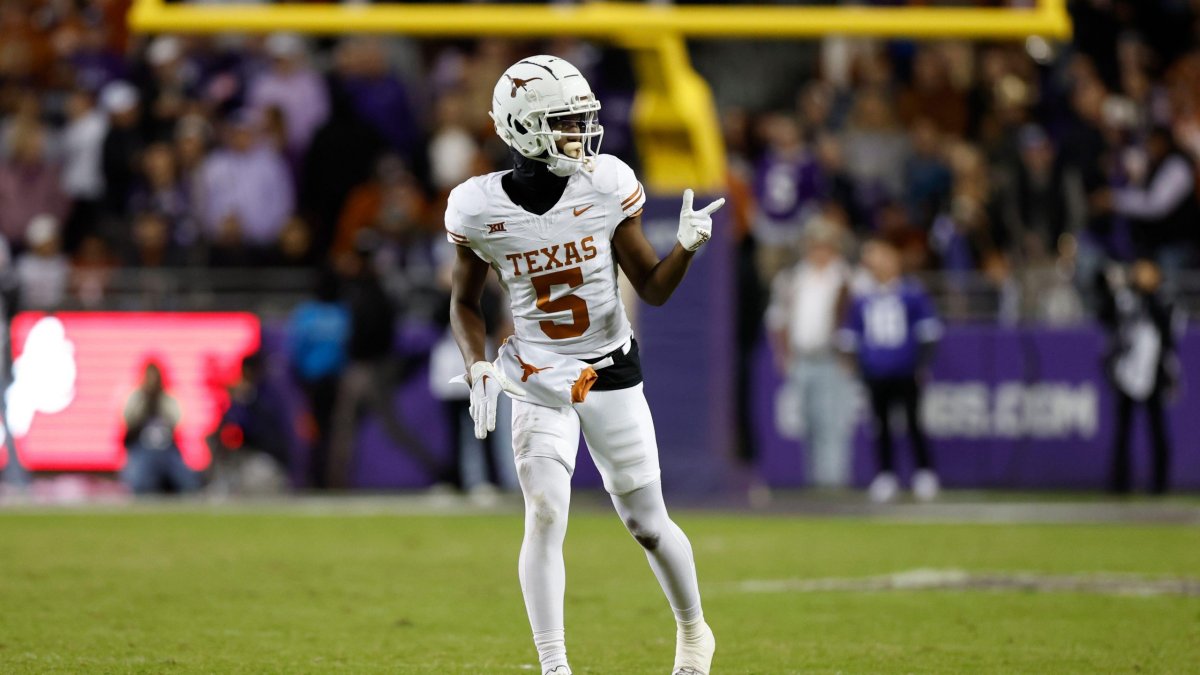



 © 2024 PFF - all rights reserved.
© 2024 PFF - all rights reserved.